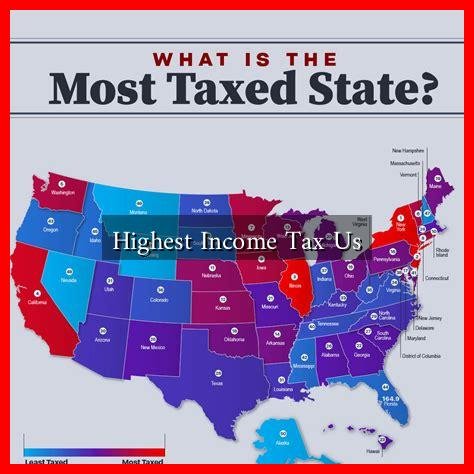-
Table of Contents
Understanding the Highest Income Tax Rates in the U.S.
Income tax is a significant aspect of the financial landscape in the United States, affecting individuals and businesses alike. The U.S. employs a progressive tax system, meaning that tax rates increase as income rises.
. This article delves into the highest income tax rates in the U.S., exploring their implications, the states with the highest rates, and how they compare to other countries.
The Progressive Tax System Explained
The U.S. federal income tax system is structured progressively, which means that taxpayers are taxed at different rates based on their income brackets. As of 2023, the federal income tax rates range from 10% to 37%. Here’s a breakdown of the federal tax brackets:
- 10% on income up to $11,000 for single filers
- 12% on income over $11,000 up to $44,725
- 22% on income over $44,725 up to $95,375
- 24% on income over $95,375 up to $182,100
- 32% on income over $182,100 up to $231,250
- 35% on income over $231,250 up to $578,125
- 37% on income over $578,125
These rates apply to taxable income, which is calculated after deductions and exemptions. The highest federal rate of 37% applies to individuals earning over $578,125, making it crucial for high earners to understand their tax obligations.
State Income Taxes: A Closer Look
In addition to federal taxes, many states impose their own income taxes, which can significantly affect the overall tax burden. Some states have a flat tax rate, while others have progressive systems similar to the federal government. Here are some states with the highest income tax rates:
- California: The highest state income tax rate is 13.3% for individuals earning over $1 million.
- New Jersey: The top rate is 10.75% for income over $5 million.
- Oregon: The highest rate is 9.9% for income over $125,000.
- New York: The top rate is 10.9% for income over $25 million.
These state taxes can add a significant amount to the overall tax burden for high-income earners. For instance, a resident of California earning $1 million would pay approximately $370,000 in federal taxes and an additional $133,000 in state taxes, totaling around $503,000 in taxes.
Comparative Analysis: U.S. vs. Other Countries
When comparing the U.S. income tax system to other countries, it’s essential to consider both the rates and the services provided in return. Many countries with high income tax rates offer extensive social services, including healthcare and education. For example:
- Sweden: Has a top income tax rate of around 57%, but citizens benefit from universal healthcare and free education.
- Denmark: The top rate is approximately 55.8%, with a strong social safety net.
- Germany: The highest rate is about 45%, with comprehensive social services.
In contrast, the U.S. offers fewer social services, which can lead to debates about the fairness and effectiveness of its tax system.
Case Studies: High Earners and Tax Strategies
High-income earners often employ various strategies to minimize their tax liabilities. For instance, many wealthy individuals invest in tax-advantaged accounts, such as 401(k)s and IRAs, or utilize deductions for mortgage interest and charitable contributions. A notable case is that of tech entrepreneurs who often leverage stock options and capital gains, which are taxed at lower rates than ordinary income.
Additionally, some high earners may choose to relocate to states with no income tax, such as Florida or Texas, to reduce their overall tax burden. This trend has been particularly noticeable among wealthy individuals in high-tax states like California and New York.
Conclusion: The Implications of High Income Tax Rates
The highest income tax rates in the U.S. reflect a complex interplay between federal and state taxation systems. While the federal government imposes a maximum rate of 37%, states like California and New Jersey add significant additional burdens for high earners. Understanding these rates is crucial for effective financial planning and tax strategy.
As the debate over tax policy continues, it is essential for taxpayers to stay informed about changes in tax laws and consider how these changes may impact their financial situations. For more information on U.S. tax rates and strategies, you can visit the IRS website.





